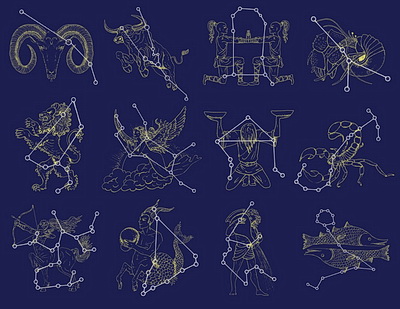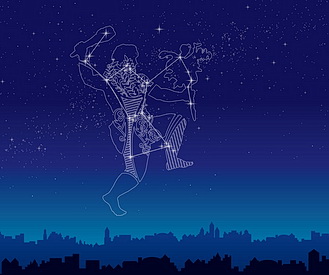
Sky Patterns
It’s a beautiful clear night and you gaze up at the sky. What do you see? Thousands of stars and perhaps even galaxies. Let’s use our imagination, just as the ancient Greeks had done, and let our creativity loose. Now, what do you see? A cow? A frog? A man with a sword?
If you see patterns, great! But if you don’t, no worries. We’ll let you know what the ancient Greeks discovered millennia ago and are still in use today.
Enter the Constellations

Constellations are officially defined as clusters of stars that make identifiable patterns for human clarification. There are a total of 88 constellations or to be a bit more creative, stars that make up characters that have been officially documented. The constellation Orion is the most well-known.
The term was coined from the Latin word constellti and was first used in astrology. The earliest records date from the Middle Bronze Dynasties from the Bronze Age which dates back from 2055 to 1650 BC. It is noted in the bible as Job 9:9, 38:31-32 – the “Maker of the Bear“. In Greek mythology, the Orion Constellation represents a hunter.
Within some of these constellations and sometimes spanning across them are smaller star patterns called asterisms. An asterism is a group of stars that form figures but are not large enough to be called a constellation.
Most Popular Constellations
We won’t discuss all of the 88 constellations, but we will pick a few that are the most well-known.
Let’s Start with Orion

In the Orion constellation, we have the Orion Nebula, which is a group of gas and dust that will form stars, some of which have already been formed.
Designated as Messier 42, we have the star Betelgeuse which is 642.5 light-years from Earth. It is a supergiant star and the second brightest star in Orion. It is located at the top left, near the top of the mythical hunter’s arm. Additionally, we have stars Saiph, Bellatrix, and Rigel to name a few more.
You might be familiar with Rigel, the crew of the Star Ship Enterprise talks about how they love to go there. Of course, it is not the star Rigel that they are visiting, but, the fourth planet revolving around it, called Rigel 4, a Goldilocks zone planet or “Class M” as Mr. Spock would say.
As mentioned, the Constellation Orion represents the mythological Greek hunter Homer. The easiest way is to find the three stars that are aligned with each other. They are Alnilam, Mintaka, and Alnitak, known as Orion’s Belt, which is at the center of Homer’s body.
On a clear night, from the northern hemisphere, just look up north. Of course, you need to be in a low-lit, wide-open location. Even if you live in a city, open areas such as parks can help you locate this popular constellation.
Ursa Major – King of the Greek Gods
Another famous constellation is Ursa Major. Latin for Great She-Bear and more popularly known to be the constellation where The Big Dipper lies, probably the most popular of all asterisms. Also known in the UK as the Plough.
The Big Dipper is well known mostly because of its navigation capabilities. If you are in the Northern Hemisphere, which is above the 35th parallel, you should be able to see it but to be a bit more realistic, those who are north of Tennessee’s southern border should be able to find it more easily.
When you look at the Big Dipper, you may not notice it, but this and the Little Dipper rotate around a star called Polaris, otherwise known as the North Star, which is one of the brightest stars in Ursa Major.
A child once mentioned that his mother told him whenever he felt sad, he should look up at the North Star and he will know he is being watched over. Parents, whether true or not, you may want to try this! Besides keeping him or her less stressed, they may learn something about the constellations and perhaps astronomy as well! Who knows? Your son or daughter may become a rocket scientist celebrity!
Let’s look back up to see where Polaris is located. It lies at the end of the handle of the Little Dipper. Now try drawing an imaginary line around the big dipper to form a Great Bear. Do you see it?
A Point of Navigation
The Big Dipper serves as a pointer to other locations in the sky. “Follow the Arc to Arcturus” is a fairly popular expression in navigation and astronomy. The “arc” can be envisioned as a curved line from the bottom of the Big Dipper and helps you locate two other popular stars called Arcturus and Spica.
So Ursa Major is quite a constellation that contains both the Little Dipper and the Big Dipper. The next time you head out, drop your GPS and compass and see if you can navigate with these stars!
The Zodiaseveral
Not a constellation, but worth mentioning before we continue discussing onward, so let’s talk about the Zodiac. This is a group of stars that cross several constellations at the vernal equinox, defined when the Earth’s rotational axis reaches a particular position and occurs in March. At this point, the following occurs:
-
- The northern and southern hemispheres receive the sun’s rays equally
- Night and day are equal in length
- Spring begins
Aries – The Ram
Aries is a constellation that is not as bright as some of the others; however, it is found in the northern hemisphere, but you may need binoculars or a telescope to find this one since only a few of its stars are visible to the naked eye.
Aries is one of the constellations that lie along the Zodiac and means “the ram” in Latin. The symbol for this constellation is the imaginary set of lines that form a ram’s horns.
Aries has a narrative behind it. It is the story of the Golden Fleece. The mythical story of Jason and the Argonauts is about the search for the Golden Fleece.
Aries contains the stars Hamal and Sheratan and interestingly enough, it also contains the spiral galaxy NGC 772 and the dwarf galaxy NGC 1156.
Orion, Ursa Major, and Aries
These are three of the most popular constellations in our night sky. We hope you gained some perspective on how the constellations came to be, their importance in navigation, their relation to astronomy, as well as a bit of Greek mythology, and some of the stars and galaxies that are contained within them. Have we sparked your interest? How about going outside to see if you can spot the Greek hunter, the Great Bear, and the ram’s horns?
